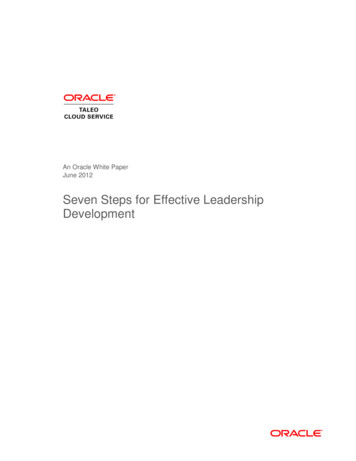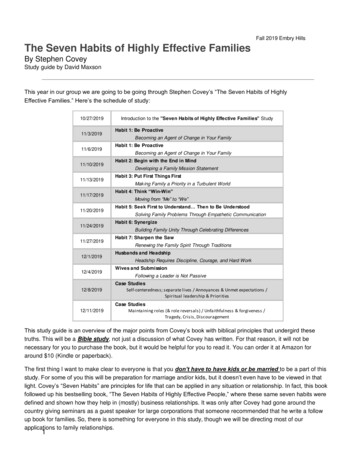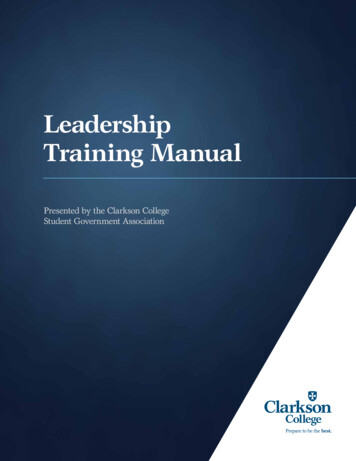
Transcription
An Oracle White PaperJune 2012Seven Steps for Effective LeadershipDevelopment
Seven Steps for Effective Leadership DevelopmentIntroduction . 1Leadership Challenges in Business . 3Elements of Leadership Development Programs . 51. Determine the Best Leadership Style for Your Organization . 72. Identify Current and Potential Leaders Within the Company . 73. Identify Leadership Gaps . 114. Develop Succession Plans for Critical Roles . 125. Develop Career Planning Goals for Potential Leaders . 146. Develop a Skills Roadmap for Future Leaders . 157. Develop Retention Programs for Current and Future Leaders . 18Conclusion . 19
Seven Steps for Effective Leadership DevelopmentIntroductionThe importance of business leadership is well articulated by this observation: A good leadercan make a success of a weak business plan, but a poor leader can ruin even the best plan.That’s why developing effective leadership by using a consistent talent management programat all levels across the organization can return significant business value. To identify, attract,fill, and retain corporate leadership talent, companies need leadership development programsfocused on hiring strategies, employee development, and career and succession planning.Currently companies are not well prepared to fill vacancies in their leadership roles. A 2008study found that only 36 percent of the surveyed companies felt prepared to immediately fillleadership positions, as shown in Figure 1.Figure 1. Companies are not prepared to fill leadership roles.The impending retirement of the baby boom generation and the crisis in leadership during theeconomic recession have further elevated the importance of leadership development in theeyes of the boardroom and shareholders.1
Seven Steps for Effective Leadership DevelopmentCompanies face two major challenges in finding and developing leaders. They need to identifyqualified candidates to fill current and future leadership roles, and they need to develop acomprehensive leadership program to cultivate and develop the leaders of tomorrow.In the past, leadership development was focused on only a few individuals in the organization.First-generation systems to assist with leadership development were siloed and/or hard to useand were not widely adopted. Companies needed a system-enabled way to unify methods ofassessing and selecting leaders, executing programs to develop skills, and measuring thesuccess of these programs.Now technology can be deployed to extend these practices across the enterprise and downinto all levels of the workforce. This white paper explores leadership challenges and highlightsthe elements of a successful leadership development program that uses technology to supportprocesses and practices.2
Seven Steps for Effective Leadership DevelopmentLeadership Challenges in BusinessFrom Enron to the prime loan mortgage crisis to AIG, leadership scandals a few years ago caused anerosion of confidence and a tremendous loss of faith in leadership of companies around the globe. In aHarvard Business Review poll, 51 percent of those surveyed said they had diminished confidence inbusiness leaders at non-U.S. companies and 76 percent had less confidence in U.S. business leaders.Figure 2. There is a tremendous loss of faith in the leadership of companies around the world. 1In addition, building and retaining good leadership has been cited as a major area of concern. In the“2008 IBM Global Human Capital Study,” more than 75 percent of the survey respondents identifiedbuilding leadership talent as their current and most significant capabilities challenge.Figure 3. This graph shows the responses to this question: “Which are the most significant capability-buildingchallenges facing your organization today?” 21Harvard Business Review, June 20093
Seven Steps for Effective Leadership DevelopmentEven with the economic downturn, management and executive roles remained among the top fivepositions employers were having the most trouble filling around the globe as of 2009. This wasconsistent with the previous year’s findings. 3The overall talent shortage has also led to challenges in leadership development, according to a globalTaleo Research 4 survey, which found that more than 80 percent of the 930 companies surveyed statedthat talent shortages were hindering their leadership development efforts.Figure 4. Global talent shortages hinder leadership development.Filling the ranks of leadership positions will be an increasing challenge as the baby boomers retire.According to PricewaterhouseCoopers (PwC) Saratoga’s “2008/2009 Human Capital EffectivenessReport,” 19 percent of managers and 29 percent of executives are eligible for retirement by 2015. Thisanticipated baby boomer drain should raise a big red flag and propel succession planning to the frontlines in the quest for future success. 5“2008 IBM Global Human Capital Study”“2009 Talent Shortage Survey,” Manpower. Note: This survey of nearly 39,000 employers across 33countries and territories gauged employers’ ability to find the talent they needed.4 Taleo was acquired by Oracle in June 2012.5 “Human Capital Effectiveness Report 2008–2009,” PwC Saratoga234
Seven Steps for Effective Leadership DevelopmentFigure 5. PwC found that 19 to 30 percent of executives and managers were eligible to retire by 2015.The recession may have postponed retirement for many baby boomers, but this is just a temporarystopgap. Although these delays have bought companies time to create succession plans for theirleaders, delivering on leadership development programs to fill these ranks will be a critical challenge inthe next one to three years. So how do we recognize leadership potential and distinguish a good leaderfrom a good manager?Successful organizations need both leaders and managers, but there are fundamental differencesbetween a manager and a leader. Whereas leaders influence, inspire, and drive people to a commongoal, the role of a manager is to keep the day-to-day operations of an organization running smoothly.Employee development must reflect these differences and provide development of both sets of skills.TABLE 1. FUNDAMENTAL DIFFERENCES BETWEEN THE ROLE OF A MANAGER AND A LEADERMANAGERIAL FUNCTIONSLEADERSHIP SKILLSPlan and budgetCreate vision and excitementCoordinate, control, and execute activitiesSet a direction and motivate and inspire people to followOrganize and staffAlign peopleWork within existing structureBuild new relationships and structuresLeadership is about influencing people so that they come to share common goals, values, and attitudes and work moreeffectively toward the achievement of the organization’s vision.– David Bartram, SHL, 20025
Seven Steps for Effective Leadership DevelopmentElements of Leadership Development ProgramsMajor talent management functions all play a part in a comprehensive leadership development programand can be well supported by a unified talent management technology platform. These functionsinclude Recruitment, to source leadership talent Assessments, to evaluate leadership capabilities both internally and externally Performance management, to monitor and make course corrections in developing leaders Succession planning, to avoid future leadership gaps Career planning, to enable employees to understand their leadership options and set developmentgoals Development, to create a roadmap to fill skills gapsA successful leadership development program begins with the alignment of leadership developmentwith company strategy and an understanding of the type of leadership style(s) needed to execute thatstrategy. A continuum of steps positions an organization for current and future leadership needs.TABLE 2. LEADERSHIP DEVELOPMENT CHECKLISTSTEPSCHECKLIST FOR LEADERSHIP DEVELOPMENT1Determine the best leadership style for your organization2Identify current and potential leaders within the company3Identify leadership gaps4Develop succession plans for critical roles5Develop career planning goals for potential leaders6Develop a skills roadmap for future leaders7Develop retention programs for current and future leaders6
Seven Steps for Effective Leadership Development1. Determine the Best Leadership Style for Your OrganizationThere are many theories about and techniques for determining the right leadership styles for anorganization. The situational leadership theory, for example, argues that the best type of leadership isdetermined by situational variables and that no one style of leadership pertains to all given workplacesituations. 6 Identifying the leadership style for an organization by using this approach includesidentification of the type of work, the complexity of the organization, and the qualifications of thefollowers.The leadership style, for instance, that is required by a head of corporate security would obviously bevastly different from the leadership style of an art museum director: authoritative versus creative orcharismatic.Additional leadership styles include pluralistic leadership that revolves around group decision-making, astyle that values the opinions of others. Whatever style is best suited for the CEO of an organization, avariety of leadership styles may be required to lead different groups such as manufacturing operations,marketing, finance, and creative services within a company.One of the main reasons for the high failure rate of new CEOs—more than half never make it past thefour-year mark—is poor organizational fit. Ability can take leaders only so far if they are notcompatible with the company culture. Here are two ways to assess leaders’ fit. Get to know them better. Psychological and behavioral assessments that are typically offered viaassessment center exercises have been statistically linked to current and future success in leadershiproles. Understand the culture better. Ask your board, employees, vendors, consultants, and others withconnections to the organization for insight into what makes an effective leader in the company.Use both sets of information to find alignments or disparities. If there is a glaring cultural conflict, beready to find a better candidate who possesses the unique skills your organization requires.2. Identify Current and Potential Leaders Within the Company“Leaders are not born; they are grown.”– Peter Drucker (widely considered the “father of modern management”), Harvard Business Review, July 14, 2009To evaluate potential leaders in the organization, a leadership program needs to identify the expectedleadership skills and competencies.6P. Hersey and K. H. Blanchard, Leadership and the One Minute Manager, William Morrow, 19997
Seven Steps for Effective Leadership DevelopmentCompetence ModelsCompetence models can be used to identify leadership potential during performance reviews andcareer counseling sessions. One model, developed by SHL, a leading assessment testing consultancy,uses SHL’s Great Eight leadership competencies. Creating and conceptualizing Analyzing and interpreting Leading and deciding Interacting and presenting Adapting and coping Supporting and cooperating Enterprising and performing Organizing and executingWhether companies develop a competence model of their own or use a model such as SHL’s, theyneed to define the success measurements and build them into their performance management system.This will assist in setting the evaluation criteria and the competence standards from a must-know andmust-demonstrate perspective.Leaders can be found both internally and externally. Companies must weigh the cost and timing ofdeveloping internal leadership against the cost and availability of hiring from the outside.Identifying Internal Leaders Through Performance ManagementBased on key leadership competencies, capabilities are tested and evaluated during the performancemanagement review process. During the performance appraisal process, managers can assess goals anddevelopment plans, solicit 360-degree feedback, and rate the individual’s progress to date.Figure 6 shows an example of a way for managers to rate the potential and performance of a leader.On the y-axis, potential is measured by the length of time it will take for a leader to be ready to assumea position. Across the x-axis are the measurements of how well the employee is performing in the role.The nine-box model in the middle tracks performance against potential. When an employee reaches ahigh level in both potential and performance, that person is ready for a promotion. Successionplanning and career planning are also a key part of the performance review cycle. 77See Steps 4 and 5, respectively.8
Seven Steps for Effective Leadership DevelopmentFigure 6. Track the potential and performance of a leader before promoting that person.Advantages of Developing Internal LeadersOne of the key advantages of developing leaders internally is that they achieve productivity almost 50percent faster than external candidates. 8 This is particularly true for organizations in which knowledgeof internal politics and structures is required to get the job done.Aberdeen Group reported that two-thirds of best-in-class companies measure the percentage of keyvacancies filled by internal candidates as a way to gauge the success of their succession planningfunction. Additionally, promoting leadership development to lower levels of the organization also has apositive impact on morale and therefore assists in employee retention. 9Leadership capabilities can be developed in several different ways, but on-the-job training is becomingincreasingly popular with company boards. Booz Allen Hamilton reported in 2009 that new CEOsbrought in from the outside to lead the company comprised about 24 percent of the incoming class,compared to 76 percent promoted from within.Furthermore, boards now appear to be “road-testing” potential leaders as chief operating officers orchief financial officers before giving them the wheel; 15 percent of new insider CEOs were auditioned,meaning that they had joined the company they now led within the past three years. 10“Mellon Financial Corporate Learning Curve Research Study”“Best in Class Talent Management Metrics,” Aberdeen Group, 200810 CEO survey, Booz Allen Hamilton, 2009899
Seven Steps for Effective Leadership DevelopmentWhen leadership positions cannot be filled from within the company and the company’s strategy is tocreate a pipeline of future leaders, recruitment should use the same measurements to test the existingcompetencies or future potential of candidates and to assess internal candidates.Identifying Leaders Through the Recruitment ProcessOne way to ensure a consistent flow of leadership talent into a company is to recruit the right people inthe first place. Online preassessments and full assessment testing can help ensure that the rightcandidates are on the short list.Online preassessment tools can also be used to accelerate the filtering process, by eliminating fromconsideration those candidates who do not pass a minimum threshold score in the preassessmentscreen. Unqualified candidates are automatically filtered out, not on the basis of their résumés but,rather, on the basis of a self-administered online test or questionnaire. The short list creation activitiesin the recruiting process are streamlined. Significant amounts of time can be saved on each jobrequisition, enabling the recruiter to focus time and attention on the more promising candidates.The advantage of using assessments is that they help you avoid wasting time during the filteringprocess—it typically takes 80 percent of the time to get to a short list. That leaves only 20 percent ofthe time to invest with quality candidates. Automated prescreening provides up to a 42 percent increasein recruiter efficiency. 11Longer assessment tests can qualify candidates for existing positions or identify potential talent to buildbench strength for future leaders. Traditional formal assessment testing is not generally used forsenior-level executives but can be useful for future rising stars during campus recruitment,management training, or leadership development programs.Case Study: Whirlpool—Creating Demand for Positions Through Innovation12With the use of technology and innovation, Whirlpool Corporation is able to attract the top talent itneeds in order to meet the challenge of staying ahead of the demand curve. The company’s success canbe measured by how fast it attracts and engages talent, an increased presence on college campuses toget that demographic excited about an appliance company, and increased interest in its leadershipdevelopment program.What were the results? Applications to the career Website for leadership development programs tripledin 2008 and 2009.1112“Hidden ROI of Talent Acquisition,” Taleo Research, 2006.“Whirlpool Focuses on Innovation to Attract Talent,” Taleo Case Study, 2010.10
Seven Steps for Effective Leadership DevelopmentIn addition, through innovation on the career Website, this century-old company is perceived bymillennials as innovative, transparent, and fun. Whirlpool gives millennials what they want, by stressingcreative solutions and thinking outside the box.Additionally, through project postings, Whirlpool is able to provide flexibility in its careerdevelopment. This is one reason Whirlpool continues to win industry awards and recognition.BusinessWeek listed Whirlpool in 2008 as one of the best places to start a career, and Fortune placed thecompany on its “Top 20 Global Companies for Leaders” list.3. Identify Leadership GapsThe identification of leadership gaps is an assessment of both the individuals and the readiness of theorganization. To help fully recognize leadership gaps, companies should Determine current and future leadership requirements Compare those requirements with the current leadership team Identify current leaders who may be at risk of leaving Identify succession plans for those at risk of leaving or planning to leave Look at the leadership development pipeline Identify gaps in skills and the time required to fill those gapsFigure 7. To determine leadership gaps, assess current leadership teams against your requirements.11
Seven Steps for Effective Leadership DevelopmentTABLE 3. EXAMPLE OF LEADERSHIP GAP ANALYSISROLERISK OFSUCCESSORSTATUSDEVELOPMENT PLANJohn JonesStatus quoJ. J. needs additional businessLEAVINGCEOLowplanning work. In year 1 ofthree-year expat assignment asEMEA president.CFOHighTwo outside candidatesStatus quoVP of OperationsLowJane SmithJ.S. ready inLeadership training in progress.one yearComplete Q3.A.C. readyOn fileDirector ofProductsMedAllen Crowtoday4. Develop Succession Plans for Critical RolesWhy is succession so important? A good succession plan is good for productivity, according to formerGeneral Electric CEO Jack Welch and former Harvard Business Review editor Suzy Welch. Successionplanning avoids disruption and employee trauma when the CEO leaves, whether the departure isanticipated or not. Succession planning should be company policy, dealt with openly and deliberatelyby corporate boards. 13Creating a succession plan for critical roles should not be confined to executive roles. As part of theleadership program, companies should evaluate critical leadership roles throughout the organization.Yet, an i4cp pulse survey found that whereas more than 70 percent of large companies have successionplans at the director level, only 41 percent have them at the manager level.A Bersin & Associates study found that a majority of companies implement succession managementpractices at only the most senior executive levels. Fewer than 40 percent of the respondents said theircompanies included midlevel managers and skilled professionals in succession planning initiatives, andjust 11 percent included first-line supervisors.Bersin’s research findings concluded that “enduring organizations”—those that survive and prosperover long periods of time—execute succession management practices across all levels of theorganization. This disparity highlights “key vulnerabilities in most organizations—a lack of bench13Kevin Oakes, “Don’t Be Like Brett Favre,” TrendWatch, Issue 463, June 12, 200912
Seven Steps for Effective Leadership Developmentstrength at the supervisory and mid-level management levels and the neglect of high-potential talent inmission-critical roles.” 14An analysis by company size shows that companies with more than 10,000 employees have a broaderview of developing leadership talent across the organization. 15TABLE 4. DRIVING LEADERSHIP DEVELOPMENT INTO THE ORGANIZATION, BY SIZE OF WORKFORCEPERCENTAGE OF COMPANIES WITH SUCCESSION PLANS FOR VARIOUS LEVELS, 16Fewer than 1,0001,000–4,9995,000–9,999More than e President Level18.9%50.0%57.1%76.2%Executive Level31.1%45.6%57.1%81.0%President Level16.2%40.9%33.3%61.9%Director Level31.1%68.2%52.4%71.4%Manager NO. OF EMPLOYEES/LEVEL“High-Impact Succession Management: Best Practices, Models and Case Studies in Organizational TalentMobility,” Bersin & Associates15 “Taking the Pulse—Succession Planning,” i4cp, July 200816 Institute for Corporate Productivity, i4cp1413
Seven Steps for Effective Leadership DevelopmentCoaching and MentoringThe apprentice model has seen a resurgence for grooming leadership. Coaching and mentoring havebeen gaining favor as elements of succession planning programs.A 2008 American Medical Association (AMA) study, “Coaching: A Global Study of SuccessfulPractices,” surveyed more than 1,000 business leaders around the world and found that nearly 60percent of North American companies use coaching for high-potential employees frequently or a greatdeal and that about 42 percent use coaching of executives to the same extent. These percentages wereeven higher in the international sample of the same AMA study.Using social media in mentoring programs is beginning to be a popular way to support externalmentoring programs.“Internal coaches often provide lower cost of services, exhibit more consistency in methods and understand the organizationalculture. However, they may also be perceived as less credible. Leaders may consider internal coaches to be less confidential.External coaches can bring greater objectivity, fresher perspectives, higher levels of confidentiality and experience in manydifferent organizations, industries and business environments.”– “Coaching: A Global Study of Successful Practices,” AMA, 2008Technology to Support Succession PlanningFor the greatest efficacy, succession planning should be supported by technology systems that providethe ability to Create backfill strategies that use data captured in the recruiting and performance review processes,coupled with individual career plans Add multiple candidates to a succession short list and view all the best options—without necessarilyadding them to the plan Display multiple talent profiles—from C-level executives to individual contributors—side by side toquickly identify the best fit Track candidate readiness based on skills, competencies, and performance; promote top candidatesbased on relative ranking and composite feedback scores5. Develop Career Planning Goals for Potential LeadersCareer planning used to be considered the responsibility of an individual. However, research showsthat companies that support career planning for their employees gain in retention, engagement, andprotection of the leadership pipeline. A 2008 Taleo Research study asked employed college graduateswhy they had left their first employer; 61 percent had left because the employer didn’t offer careeradvancement or organizational opportunities.According to a 2009 Taleo Research paper, “Engaging Times,” workers need more than a job. Even ina recession, they require a higher level of engagement that employers are not currently providing.Findings from the study include these glass-half-empty/half-full observations: Only14
Seven Steps for Effective Leadership Development 45 percent have visibility into internal job opportunities 42 percent can see their next step up the career ladder 57 percent have career communications with their employer 40 percent have access to online career toolsEven if employees are not actively looking for a job, one survey found that one in three of theresponding employees had recently been approached by another organization hoping to lure themaway and that 77 percent of workers ages 36 to 40—right in the pipeline for leadership—last in newjobs less than five years. 17If companies do not provide employees with career planning and advancement opportunities, theircompetitors will. Self-service career planning will help motivate and retain talent, by empoweringemployees to view a career plan and generate their own within the company.Combining employee development with career planning enables employees not only to explorepotential career paths but also to monitor and progress through the development activities necessary toattain them. Competencies can then be tied to relevant development activities, thereby incorporatingdevelopment planning right into the performance review process, which supports career developmentand succession planning.6. Develop a Skills Roadmap for Future LeadersOnce the high-potential employees have been identified, a skills roadmap should be developed for thefuture leaders. Because people learn and develop new skills both inside and outside the classroom, adevelopment program needs to support both traditional and nontraditional learning.To support less-formal learning, activities such as coaching, rotational assignments, job shadowing,mentor relationships, and project leadership should also be part of an employee’s development plan. Atthe core, the very definition of learning should reflect today’s nontraditional learning and incorporatesocial networking tools into the development process.“The Battle for Brainpower,” in “The Search for Talent: Why It’s Getting Harder to Find” (special reportin The Economist, October 7, 2006)1715
Seven Steps for Effective Leadership DevelopmentFigure 8. Develop a skills roadmap for future leaders.A “Tomorrow’s Leaders” study by Henley Management College highlighted particular skills gaps incommunication and team bonding as well as the appropriate use of emerging technologies.Figure 9. Henley Management College studied the effectiveness of skills development programs for developingleaders. 18“In Challenging Times, Leadership Skills and Leader Development Matter,” Workforce ManagementMagazine, February 24, 20091816
Seven Steps for Effective Leadership DevelopmentCase Study: Coca-Cola—Leadership Development Delivers the Goods19Stevens J. Sainte-Rose, group HR director at Coca-Cola, says, “The uniqueness of Coca-Cola is inengaging consumers with the brand, so marketing talent is key. Without the right people, we can’tdeliver the winning formula.”Coca-Cola therefore embarked on a pioneering bespoke program to not only identify its risingmarketing stars but also to plan their development, ensuring that the company had a strong pipeline ofhighly creative and innovative thinkers who could be the marketing leaders of tomorrow filling seniorvacancies around the world.In developing a bespoke program, Coca-Cola chose to partner with international assessmentconsultancy SHL, which worked with Coca-Cola’s talent professionals and senior marketing leaders tocreate a two-day development program for high-potential marketers aspiring to become seniormarketing leaders.Looking to its strongest-performing marketers, Coca-Cola developed a set of competencies to definethe “ideal” skills and behaviors of a senior marketing leader. This was undertaken with the globalbackdrop in mind, to ensure that competencies were calibrated internationally, allowing for a levelplaying field that did not disadvantage any participants.Eight handpicked marketers were then chosen to undertake a two-day pilot in Europe. Although thepilot ran in Paris, Coca-Cola participants came from all over the world. The aim was for existingmarketing leaders of the business to see and develop potential from as many geographies as possible,making selection of the best as equitable and as representative as possible.The program was also designed to give participants an opportunity to bond and establish a globalalumni network of supportive colleagues that would continue beyond the event. Extremely seniorCoca-Cola marketers made up an observer panel alongside highly experienced occupationalpsychologists from SHL, proving Coca-Cola’s commitment and dedication to the program.So successful has the development program been that Coca-Cola and SHL now run it every three tosix months in locations around the world in an effort to ensure that Coca-Cola will never have to lookoutside its own talent pool to fill key strategic marketing positions vital to maintaining the iconic CocaCola brand image.The company’s mission is “to refresh the world . in body, mind and spirit,” and Coca-Cola acceptsthat to do this, its vision needs to include “being a great place to work where people are inspired to bethe best they can.”This case study is based on an SHL article entitled “The Coca-Cola Company Partners with SHL toIdentify Future Senior Marketing Leaders,” available on the SHL Website (shl.com).1917
Seven Steps for Effective Leadership Development7. Develop Retention Programs for Current and Future LeadersMonetary as well as nonmoneta
7 See Steps 4 and 5, respectively. Seven Steps for Effective Leadership Development 9 . Figure 6. Track the potential and performance of a leader before promoting that person . Advantages of Developing Internal Leaders . One of the key advantages of developing leaders










